StarTech Standalone Hard Drive Eraser And USB 3.0 Dock Capsule Review
by Billy Tallis on February 16, 2016 8:00 AM EST- Posted in
- Storage
- USB 3.0
- SATA
- DAS
- StarTech.com
Random Read Performance
The random read test requests 4kB blocks and tests queue depths ranging from 1 to 32. The queue depth is doubled every three minutes, for a total test duration of 18 minutes. The test spans the entire drive, making it a worst-case scenario for the mechanical hard drive and its high seek time.
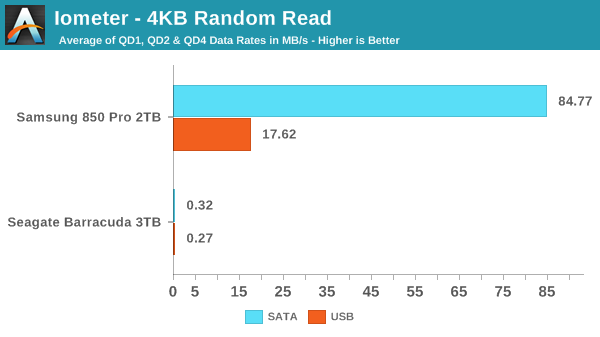
The impact of the dock on performance is much more severe for the random read test than for either of the sequential tests. The SSD's performance is only about a fifth of its native SATA speed despite the throughput in this test being nowhere near the limits of the dock. Even the painfully slow hard drive was measurably slowed by the dock, showing that it imposes a clear per-request latency overhead.
 |
|||||||||
| Samsung 850 Pro 2TB (SATA) | Samsung 850 Pro 2TB (USB) | ||||||||
| Seagate Barracuda 3TB (SATA) | Seagate Barracuda 3TB (USB) | ||||||||
The queue depth scaling for the hard drive had to be graphed with a very different scale for performance, but we are able to observe the effect of Native Command Queuing. The overhead of the dock on the hard drive has the effect of reducing the queue depth to a fourth of its actual value. The SSD's performance in the dock across queue depths is mostly flat but again slightly slower at QD1.
Random Write Performance
The random write test is conducted with the same timing and queue depths as the random read test, but is limited to a 16GB span of the drive. For SSDs, this ensures that the drive has plenty of spare area to perform wear leveling and garbage collection without hurting performance. For hard drives, this greatly limits the maximum seek distance and thus improves the average seek time.
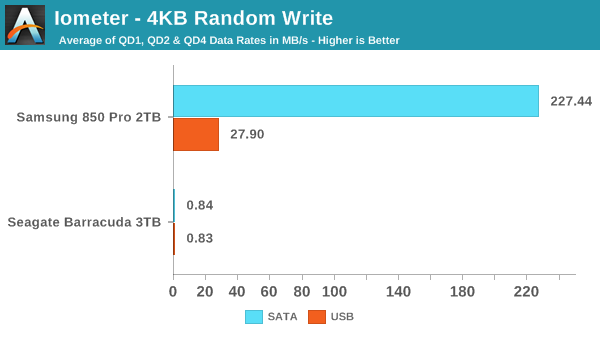
The key to the fast random write performance of SSDs even at low queue depths is that the drive will buffer writes, signaling completion before the data has actually been fully written to flash. Without this capability, the inherently slower write speed than read speed would be readily apparent. Even in the latency-challenged eraser dock, the SSD's quick turnaround time for write commands provides a significant benefit. For the hard drive, the overhead of the dock is very small and the restricted range of the test allows the random writes to be three times faster than the random reads across the entire disk.
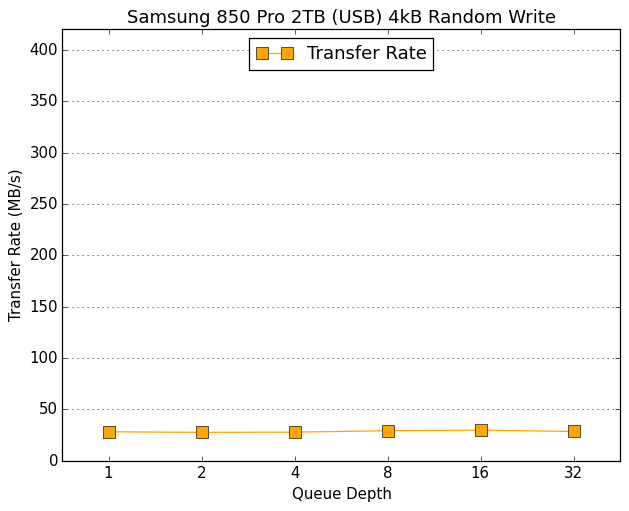 |
|||||||||
| Samsung 850 Pro 2TB (SATA) | Samsung 850 Pro 2TB (USB) | ||||||||
| Seagate Barracuda 3TB (SATA) | Seagate Barracuda 3TB (USB) | ||||||||
The queue depth scaling of the SSD doesn't present any surprises, but the hard drive's performance is interesting. Both in the dock and connected internally, the hard drive's performance peaks at QD4, suffers as the queue depth increases to 8 and 16, and recovers some at QD32. This might represent a limitiation of this drive's NCQ implementation. Note that the hard drive's drastically lower random I/O performance again required a different vertical scale from the SSD.
Mixed Random Read/Write Performance
The mixed random I/O benchmark starts with a pure read test and gradually increases the proprotion of writes, finishing with pure writes. The queue depth is 3 for the entire test and each subtest lasts for 3 minutes, for a total test duration of 18 minutes. This test is restricted to a 16GB span of the drive.
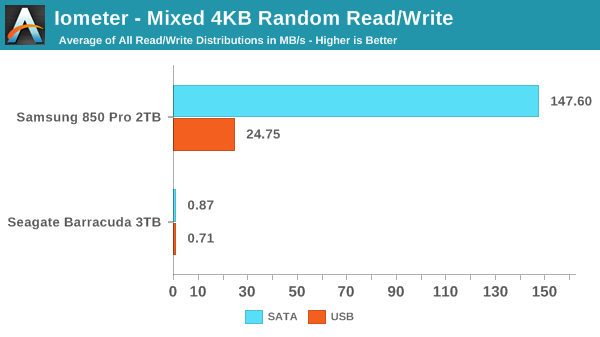
The overall scores on the mixed random test are unsurprisingly pretty similar to the separate random read and write scores. The limited span and increased queue depth help some, especially for the mechanical drive, while the SSD's averages fall between its random read and write scores. The dock continues to impose a severe performance penalty on the SSD and a slight one for the hard drive.
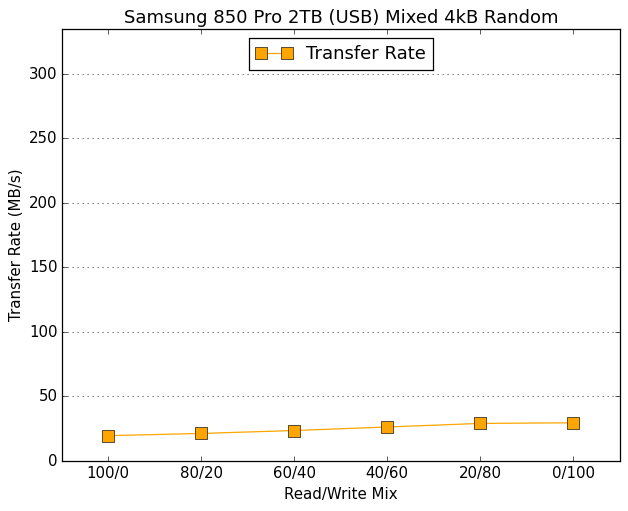 |
|||||||||
| Samsung 850 Pro 2TB (SATA) | Samsung 850 Pro 2TB (USB) | ||||||||
| Seagate Barracuda 3TB (SATA) | Seagate Barracuda 3TB (USB) | ||||||||
As with the other random tests, the hard drive had to be graphed on a different scale from the SSD. In the dock, the SSD demonstrates a slight increase in performance as the workload becomes more write-heavy and it is not able to show the large improvement when reaching the pure-write portion of the test. The hard drive's performance in the dock retains the same basic profile as when connected internally, but suffers in every subtest save for the pure-write portion.










38 Comments
View All Comments
Murloc - Tuesday, February 16, 2016 - link
I guess the point of this thing is being easy to use for employees, the time is not really a concern if you have other work to do anyway.The USB dock thing looks like something they just slapped there since people may want to check what's on a drive they found before wiping it. So performance is not really key.
edzieba - Tuesday, February 16, 2016 - link
The "erase by overwriting" method is completely redundant for any HDD implementing ATA SECURE ERASE. Not only is SE the fastest method to wipe data (limited only by the drive controller, not the interface) it wiped sectors in the G-list that a normal wipe would miss. This includes DBAN and other redundant multi-overwrite methods. Multiple overwrites have been entirely unnecessary since the invention of the GMR head well over two decades ago.Babar Javied - Tuesday, February 16, 2016 - link
Expand please?I have never even heard of ATA secure erase but it sounds interesting. How does this make overwriting redundant? since the data on the platters does need to be erased
joex4444 - Tuesday, February 16, 2016 - link
It's a little surprising you've never heard of it since it was mentioned in the 3rd paragraph of the article, albeit quickly.Guspaz - Tuesday, February 16, 2016 - link
This assumes that you trust the drive's secure erase implementation. Following up the secure erase with a single overwrite is probably sufficient.Azethoth - Wednesday, February 17, 2016 - link
Exactly. Secure erase on SSD just marks all blocks as empty, so factory default but the data is really still there. Absent proof of no physical way to access these blocks and read their data you really do need to overwrite at least once and take the hit to longevity ;-)azrael- - Thursday, February 18, 2016 - link
Apparently you didn't read the article either (or anywhere else it has been written). Securely erasing an SSD usually consists of the drive throwing away the encryption key it has used for storing your data. The data is still there, but noone can read them.Senti - Friday, February 19, 2016 - link
The keyword here is "usually". Imagine you are the one responsible for secure deletion of information: would you blindly believe that "drive should do it properly and not leave the old key somewhere" or would you double-check? The answer is obvious.Lerianis - Saturday, February 20, 2016 - link
Considering that this is being done by tech literate organizations. I think they would have verified the whole "No way to restore the drive!" that they are pushing.leexgx - Saturday, February 20, 2016 - link
i guess he should of not used the word "usually"if the drive uses AES encryption (SED drive) then all the drive has to do is reset the key when Secure erase is done (this is why it can take upto 1-2 hours to wipe none encryption HDD drive) and all data is lost and if that is not enough it also commands the Trim all parts of the flash so all NAND is clean all parts of the SSD will come back with 00000000 (unlike a HDD there is a chance to recover data but if its a self encryption HDD/SSD drive then there is no data recovery once ATA Secure erase has been used)
if ATA secure erase takes more than 2 minutes on a Self encrypting drive(HDD or SSD), the drive it self is not encrypted as SED drives should just reset the keys and all data has gone puff (full TRIM on all parts of the flash is also performed as well to bring the drive to a complete clean and max performance state)
on SSDs even none SED drives a secure erase should only take 30 seconds - 2 minutes as all it has to do is command reset the pages and TRIM the whole drive witch is a very fast task